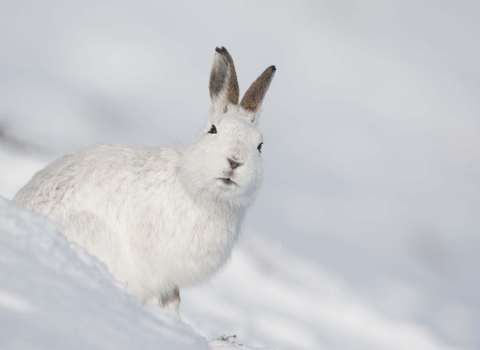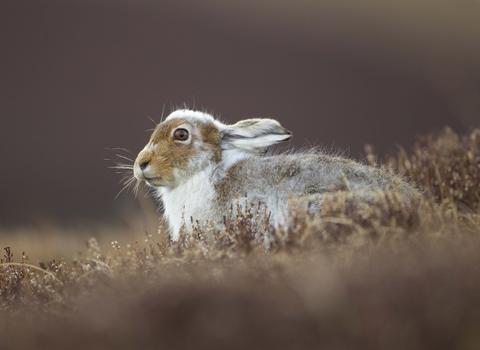
Mountain hare ©Mark Hamblin/2020VISION

©Mark Hamblin/2020VISION

©Mark Hamblin/2020VISION
Mountain hare
Scientific name
Lepus timidusWhen to see
January to DecemberSpecies information
Category
Statistics
Length: 45-56cmWeight: 2.5-3.5kg
Average lifespan: 3-4 years
Habitats
About
The mountain hare lives in Scotland and the north of England. It lives in upland areas and is most common on heathland, where it grazes on vegetation and the bark of young trees and bushes. Mountain hares do not dig burrows, but shelter in 'forms', which are shallow depressions in the ground or grass; when disturbed, they can be seen bounding across the moors, using their powerful hind legs to propel them forwards, often in a zigzag pattern. Mountain hares are at their most visible in spring, when the snow has melted, but they still have their white, winter coat. Females produce one to four litters of one to three young (known as leverets) a year.How to identify
The mountain hare has a grey-brown coat in summer, with a bluish tinge, and turns white in winter - only its ear tips stay black. The Irish hare may remain brown even in winter and its coat has a reddish tinge. Mountain hares are larger than rabbits, but smaller than brown hares and have shorter ears.Distribution
Found in the Scottish Highlands, where it is native, and also in the Peak District and on some Scottish islands, where it has been introduced. A subspecies, the Irish hare, is found in Ireland.In our area
Often called ‘blue hares’ on the Isle of Man, these animals were originally native to the Island, but became extinct at some point in the last thousand years or so. However, in the 1950s and 60s a small population was re-introduced from Scotland and they have now spread successfully throughout most of the northern hills of the Island. They are not found south of the central valley. At present their numbers appear stable, but with our warming winter climate and lack of snow or frost, their winter white coat, rather than disguising them against a snowy white background, makes them stand out clearly in the heather uplands making them easy quarry for birds of prey.
Did you know?
Unlike the brown hare, which was introduced in Roman times and is now naturalised, the mountain hare is native to the Scottish Highlands (but introduced elsewhere in the UK). The Irish hare (Lepus timidus hibernicus) is a subspecies of the mountain hare that can only be found in Ireland.Often called ‘blue hares’ on the Isle of Man, these animals were originally native to the Island, but became extinct at some point in the last thousand years or so. However, in the 1950s and 60s a small population was re-introduced from Scotland and they have now spread successfully throughout most of the northern hills of the Island. They are not found south of the central valley. At present their numbers appear stable, but with our warming winter climate and lack of snow or frost, their winter white coat, rather than disguising them against a snowy white background, makes them stand out clearly in the heather uplands making them easy quarry for birds of prey.
